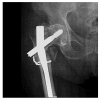Failure Analysis of Retrieved Osteosynthesis Implants
- PMID: 32155981
- PMCID: PMC7085058
- DOI: 10.3390/ma13051201
Failure Analysis of Retrieved Osteosynthesis Implants
Abstract
Failure of osteosynthesis implants is an intricate matter with challenging management that calls for efficient investigation and prevention. Using implant retrieval analysis combined with standard radiological examination, we evaluated the main causes for osteosynthesis implant breakdown and the relations among them for a series of cases. Twenty-one patients diagnosed with implant failure were assessed for this work. For metallurgical analysis, microscopy techniques such as scanning electron microscopy (SEM), stereomicroscopy, and optical microscopy were employed. The results showed that material structural deficiencies (nine patients) and faulty surgical techniques (eight patients) were the main causes for failure. An important number of patients presented with material structural deficiencies superimposed on an imperfect osteosynthesis technique (six patients). Consequently, the importance of failure retrieval analysis should not be overlooked, and in combination with other investigational techniques, must provide information for both implant manufacturing and design improvement, as well as osteosynthesis technique optimization.
Keywords: analysis; failure; implant; osteosynthesis; retrieval.
Conflict of interest statement
The authors declare no conflict of interest
Figures






References
-
- Marinescu R., Antoniac V.I., Stoia D.I., Lăptoiu D.C. Clavicle anatomical osteosynthesis plate breakage-failure analysis report based on patient morphological parameters. Romanian J. Morphol Embryol. 2017;58:593–598. - PubMed
-
- Atasiei T., Antoniac I., Laptoiu D. Failure causes in hip resurfacing arthroplasty–retrieval analysis. Int. J. Nano Biomater. 2011;3:367–381. doi: 10.1504/IJNBM.2011.045882. - DOI
-
- Bane M., Miculescu F., Blajan A.I., Dinu M., Antoniac I. Failure analysis of some retrieved orthopedic implants based on materials characterization. Solid State Phenom. 2012;188:114–117. doi: 10.4028/www.scientific.net/SSP.188.114. - DOI
-
- Grecu D., Antoniac I., Trante O., Niculescu N., Lupescu O. Failure analysis of retrieved polyethylene insert in total knee replacement. Mat. Plast. 2016;53:776–780.
LinkOut - more resources
Full Text Sources

